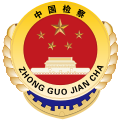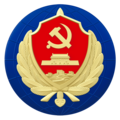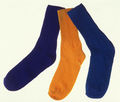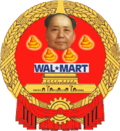Forbidden City
The Forbidden City is a city you cannot get in. Well...ummm... Actually you couldn't get in, if you lived in 15th century China. But you are reading this article right now, so I suppose you don't live in 15th century China. D'oh! Here we go again.
The Forbidden City was the Chinese Imperial palace from the Ming Dynasty to the end of the Qing Dynasty. It was built in 1406 to 1420, in case you care. It is located in the middle of Beijing and it served as the home of emperors and their households, as well as the ceremonial and political center of Chinese government. Since yesterday it houses the magnificent Palace Museum, in which you can find a large collection of Chinese toys and other made-in-china things.
The Forbidden City is a UNESCO designated world-heritage site, noted for its massive size and only.
Name[edit | edit source]

Originally, the Chinese called it Purple Forbidden City. The emperor thought that it is a better name, because it sounds more artistic. I mean, if it was called just Forbidden City, everyone would be afraid of it. But Purple Forbidden City is totally different, isn't it? Also, many approved historians claim that it was called Purple Forbidden City with colourful tiles, white walls and yellow bulbs on the roof. Anyway, it was named like that since nobody except the imperial family and the state officials couldn't walk in. In fact, he could get in, but if he did, he would lose his head.
History[edit | edit source]
The construction of the Forbidden City began in 1406, on the orders of Emperor Yongle. His predecessor was living in Nanjing, but when Yongle saw a raven shiting in a rice paddy, he thought it was a good omen. Construction lasted 15 years, and required more than a million volunteer workers.[1] Extremely luxurious material were used, including gold, porcelain (of course) and silicon. The Emperor wanted to have neon signs, but it wasn't invented back then. The final result was really good and the Emperor was pleased.
In 1644 some lout rebels got in, but they were soon driven out by Jackie Chan. Unfortunately, a few buildings were destroyed due to his kung-fu techniques. The next Emperor, of the Qing Dynasty, had a renovation and also added a tennis court. Since then, all Emperors made important design changes to match feng shui.
During the Second Opium War, Anglo-French forces took control of the Forbidden City. As usual, the French retreated, even though there was no threat. The British army stayed there for a few months. Lord Elgin wanted to take some marble statues (again) and golden stuff, but he was afraid of Bruce Lee's wrath. When the soldiers left, the Chinese were terrified by their dirt.
During the infamous Boxer Rebellion, some rebels got in the Forbidden City. Nevertheless, they were lost in the huge palace and never came out alive. Their bones were accidentaly found by Oscar Wilde many years later. In 1912, Emperor Puyi was abdicated, even though he was only an innocent child. Commons were allowed to get in the Outer Court for the first time since the City was built. Many people though, didn't revered their own culture and did many silly graffiti on the walls.
In 1933, the Japanese invaded China. They weren't interested in tourism however and didn't visit the Forbidden City. During the Chinese Civil War, Chiang Kai Shek stole some imperial stuff and took them to Taipei, Taiwan. Chairman Mao didn't care at all, as he had more imperial things.
At the height of Mao's Cultural Revolution, the Forbidden City was the cultural centre of China. Mao held fancy communist celebrations with many guests, such as Stalin and Marx. He also used to sing and recite poems over charmed crowds.
In recent years, the Palace Museum became a great tourist attraction. Today, it's totally modern with a big Starbucks store, many souvenir shops and a fine McDonald's restaurant.
Architecture[edit | edit source]
Well, I'm not an architect and I'm sure you don't want to read anything about architecture. The only thing that matters is the size. The whole complex covers 7,800,000 sq ft. MASSIVE!
Exhibits[edit | edit source]
There are many interesting exhibits in the Palace Museum, not including the following:
Wooden dildo of the Empress
See also[edit | edit source]
References[edit | edit source]
- ↑ Or slaves.








